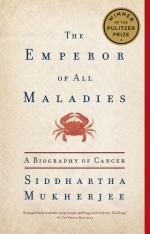
|
| Name: _________________________ | Period: ___________________ |
This test consists of 15 multiple choice questions and 5 short answer questions.
Multiple Choice Questions
1. Dissenting voices began to be heard. How many major arguments existed?
(a) Five.
(b) Three.
(c) Four.
(d) Two.
2. In _________ John Bennett, a Scottish physician, had described the case of a 28-year-old slate layer who complained of a mysterious swelling in his spleen.
(a) 1835.
(b) 1885.
(c) 1845.
(d) 1905.
3. The year of his death, 1972, marked what?
(a) The beginning of a deeply fractured and contentious period in the history of cancer.
(b) The end of a deeply fractured and contentious period in the history of cancer.
(c) The beginning of new cancer research.
(d) The beginning of huge strides in cancer research.
4. Every battle needs its iconic battleground, and one physical place epitomized the cancer wars of the late _________.
(a) 1960s.
(b) 1970s.
(c) 1980s.
(d) 1950s.
5. People began to develop what regarding cancer?
(a) A sense of peace regarding the disease.
(b) A sense of awareness about the disease.
(c) An immunity to the disease.
(d) An internal fear about the disease.
6. What does Cole say this theorist lacked?
(a) The case studies to support his claims.
(b) The research to back up his claims.
(c) The intelligence to achieve his goals and to execute the procedure correctly.
(d) The right tools to achieve his goals and to execute the procedure correctly.
7. How did therapies need to be developed?
(a) From the bottom up.
(b) From completely new research.
(c) From the top down.
(d) From old research and studies.
8. Who is Ben Orman?
(a) An artist who found a lump in his arm.
(b) An athlete who found a lump in his neck.
(c) A student who found a lump in his side.
(d) A doctor who found a lump in his leg.
9. The researchers met with Howard Skipper, a "_______________" who had been injecting rodents with leukemic cells.
(a) Mouse doctor.
(b) Cat doctor.
(c) Children's doctor.
(d) People's doctor.
10. Minot's research pertained mostly to ________________ anemia.
(a) Iron deficiency.
(b) Sickle cell.
(c) Vitamin deficiency.
(d) Pernicious.
11. Robert would eventually die but he and many other patients had survived past the ______________ period. At the time, this was an eternity.
(a) Two year.
(b) Nine month.
(c) One year.
(d) Six month.
12. "The Emperor of all Maladies" begins with the tale of Carla Reed, a _______ year old kindergarten teacher from Ipswich, MA.
(a) 40.
(b) 30.
(c) 25.
(d) 55.
13. The parcel Farber was expecting contained aminopterin, a __________ crystalline chemical that Farber hoped could be used in deterring the growth of childhood leukemia.
(a) Red.
(b) Yellow.
(c) Green.
(d) Blue.
14. Farber was fortunate to have lived in the right time, but he was perhaps even more fortunate for what reason?
(a) To have been a pathologist.
(b) To have made so many great discoveries.
(c) To have died at the right time.
(d) To have died from something other than cancer.
15. Virchow began to notice uncontrolled growth of cells. Virchow referred to this as _____________ or distorted growth.
(a) Alloplasia.
(b) Physioplasia.
(c) Neoplasia.
(d) Pseudoplasia.
Short Answer Questions
1. In hypertrophy, the number of cells __________ change.
2. The first VAMP trial was launched in ___________. The results were abysmal. Refinements showed progress and even success. However, the cost was quite high for the young patients.
3. A final report from the panel agreed about what?
4. The author, Siddhartha Mukherjee, learned about Carla after she had checked into Massachusetts ______________ Hospital.
5. The only way to test these different beliefs about Halstedian theory was to do what?
|
This section contains 560 words (approx. 2 pages at 300 words per page) |

|




